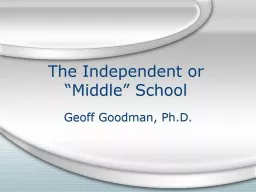/


Geoff Goodman PhD I Major Figures of the Independent School William Fairbairn Donald Winnicott Harry Guntrip Michael Balint John Bowlby II Shared Assumptions of the Independent School The primacy of objectseeking over instinct gratification ID: 613152
Download Presentation The PPT/PDF document "The Independent or “Middle” School" is the property of its rightful owner. Permission is granted to download and print the materials on this web site for personal, non-commercial use only, and to display it on your personal computer provided you do not modify the materials and that you retain all copyright notices contained in the materials. By downloading content from our website, you accept the terms of this agreement.
Slide1
The Independent or “Middle” School
Geoff Goodman, Ph.D.Slide2
I. Major Figures of the Independent School
William Fairbairn
Donald Winnicott
Harry Guntrip
Michael Balint
John BowlbySlide3
II. Shared Assumptions of the Independent School
The primacy of object-seeking over instinct gratification
Ego and objects are always connected by an affective link
Drive energy is not inherent in the existence of the ego and objects
Helplessness or infantile dependence on the mother is the primary state of being, not primary narcissismSlide4
Continued…
E. Separation anxiety is the primary subject matter of psychopathology, not castration anxiety and the Oedipal conflict
F. Deficiencies in caregiving environment, not conflict between drives and society, are the ultimate cause of psychopathologySlide5
Continued…
G. Development proceeds not in psychosexual stages but from infantile dependence to mature dependence
H. Psychopathology is derived from an accommodation to maternal caregiving, not a distortion of it through the cycle of projection and introjection
I. The integrity of the self determines drive modulation, not drive intensity Slide6
Continued…
J. Aggression is not a constitutional drive but emerges from frustration with a seductive or unresponsive, unmirroring caregiving environment
K. Treatment consists of unblocking the natural process of development toward mature dependence to overcome caregiving deficits rather than making interpretations to integrate intrapsychic conflicts Slide7
Continued…
L. Infant is prewired for adaptation and adjustment rather than initially psychotic and later depressed (a developmental achievement)
M. Repression consists of making unconscious certain aspects of the caregiver-infant relationship rather than exclusively traumatic memories or forbidden impulses Slide8
III. The Theory of William Fairbairn
The infant begins with a whole, harmonious ego
The ego becomes split from this initial whole
1. libidinal ego
a. connected to exciting object
1) repository for hopes of connection and gratification
2) idealized aspects of frustrating experiences with object
b. experiences of seduction and unfulfilled needs by real objectSlide9
Continued…
2. antilibidinal ego
connected to rejecting object
1) repository of anger and wish to withdraw from objects to protect from pain of abandonment
2) devalues aspects of rejecting experiences with object and relations with all objects
b. experiences of rejection and abandonment by real objectSlide10
Continued…
3. central ego
connected to ideal object (moral defense) and real object in external world
b. basis
for all external relations with real people
c.
energy devoted to relationships with real objects siphoned off by relationships to exciting object and rejecting objectSlide11
Continued…
4. infant develops these objects in relation to both mother and father, which are integrated into one rejecting object and one exciting objectSlide12
Continued…
C. Libido is adhesive and becomes attached to “bad” objects--rejecting and exciting objects--to compensate
bad objects internalized to exercise control over them
bad objects internalized to preserve goodness of the real object and keep alive the hope that if the infant or child changes, love will be forthcoming Slide13
Continued…
3. primary motivation is human contact, not pleasure
4. psychosexual stages of libidinal development represent different modes of relatedness to objects
5. all psychosexual conflicts are reduced to oral conflictsSlide14
Continued…
D. Aggression is not a primary motivational factor
reaction to frustration of libido (antilibidinal)
aggression expressed through antilibidinal ego against rejecting object and exciting object (withdrawal of real relations)
antilibidinal ego can be directed against therapist’s awakening of hope, represented in the transference as an exciting objectSlide15
Continued…
E. Three developmental phases
1. infantile dependence (relations with real and compensatory objects)
2. transitional phase
3. mature dependence (renunciation of attachment to rejecting and exciting objects and real objects) Slide16
Continued…
F. Cure--renunciation of these attachments and restoration of split-off ego to original integrity
conflicts among these three object relations create schizoid personality
establishment of relationship with loving object helps to heal these schisms in the psycheSlide17
IV. The Theory of Donald Winnicott
The infant begins as a mother-infant unit
The infant wishes for fulfillment of needs
1. mother presents fulfillment as infant wishes for it
2. moment of illusion of infantile omnipotenceSlide18
Continued…
C. Primary maternal preoccupation wanes
gradual disillusionment of infant’s omnipotence
introduction of objective reality
D. Pace of disillusionment
1. transitional object cushions fall from omnipotence by creating potential space between the real world and the infant’s omnipotent world
Slide19
Continued…
2. infant permitted to destroy transitional object because it is not totally under infant’s control, which survives attacks and therefore becomes real--outside infant’s omnipotent control Slide20
Continued…
3. impingements--maternal intrusions that prematurely accelerate disillusionment process
withholding of gratification during excited affect states
interference with infant’s capacity to be alone--infant’s formlessness and unintegration in quiescent affect statesSlide21
E. Formation of false self
hiding of true desires and innate vitality from oneself and one’s caregivers
impingements force self to focus on environment rather than internal subjective experience
a feeling of alienation from oneself results
false self protects integrity of true selfSlide22
Continued…
F. Cure--not interpretation but manner in which the analytic setting provides missing parental provisions and fills early developmental needsSlide23
V. Critique of the Independent School
Overemphasis of the role of the environment and underemphasis on the role of genetics
Greater likelihood of boundary violations in clinical practice (see Ferenczi)
Naïve reconstruction of infancy in the adult mind
Little empirical evidence (reliving birth process on couch)